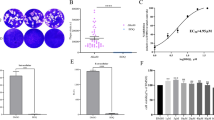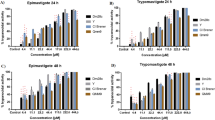Abstract
Purpose
Oxidative stress is an essential component of innate response against microbes. The oxidative impact has a very subtle connection with apoptosis. Our previous work indicated presumptive evidence of apoptosis by the chalcone derivatives against the human lymphatic filarial parasite. Evidence suggests the involvement of glutathione-S-transferase (GST) in the mechanism of action of chalcone drugs. In the present study, we explored the implications of redox status in apoptosis of the parasite by this drug.
Results
Treatment with the representative drug, 4t, significantly decreased GSH level and increased GST activity in the Brugia malayi microfilariae (Mf) in comparison to Mf without 4t treatment. Drug-induced loss of motility of the parasites was reversed by the treatment with GSH (41%) and NAC (19%). A significant fall in rGST activity was observed due to drug addition, which could be reversed by the addition of GSH co-substrate, but not with the re-addition of rGST, indicating a vital role of GSH. In silico study demonstrated a favorable drug–GST enzyme interaction. Oxidative stress was reflected by increased protein carbonylation and intracellular reactive oxygen species level, in the drug-treated parasite. Mitochondrial oxygen consumption was reduced by the drug, which was reversed on the addition of GSH. Mitochondrial dysfunction was confirmed by MTT and cytochrome c assay. Apoptosis was confirmed by the inhibition in PARP activity.
Conclusion
We conclude that the depletion of GSH by chalcone with concomitant mitochondrial dysfunction revealed a novel rationale of apoptosis in the parasite. Such a mechanism might have wide therapeutic implications.



Similar content being viewed by others
References
Mogensen TH (2009) Pathogen recognition and inflammatory signaling in innate immune defenses. Clin Microbiol Rev 22(2):240–273. https://doi.org/10.1128/CMR.00046-08
Maizels RM, Denham DA (1992) Diethylcarbamazine (DEC): immunopharmacological interactions of an anti-filarial drug. Parasitology 105(S1):S49–S60. https://doi.org/10.1017/S0031182000075351
World Health Organization (2017) Lymphatic filariasis: Fact sheet updated on March 2017. https://www.who.int/mediacentre/factsheets/fs102/en/. Accessed 13 Feb 2019
Celone M (2015) Barriers to the elimination of lymphatic filariasis in Sub-Saharan Africa. Spring 5:26–32. https://doi.org/10.7916/thejgh.v5i1.5297
Bhattacharjee J (2016) Mass drugs administration in India-a failure story. Epidemiology Open Access 6:252. https://doi.org/10.4172/2161-1165.1000252
Zuchi A, Prust LT, Rocha A, Araújo J, da Silva PS, Fiorillo K, Brandão E, Ximenes C, Lopes F, Ponzi CC (2017) Screening and evaluation of lymphatic filariasis in immigrants from endemic countries residing in a focus where it is considered eliminated in the Southern Region of Brazil: A risk of reemergence? Acta Trop 176:192–196. https://doi.org/10.1016/j.actatropica.2017.08.010
Peixoto CA, Santos ACO, Ayres CFJ (2008) Molecular evidence for apoptosis in microfilariae of Wuchereria bancrofti induced by diethyl carbamazine. Parasitol Res 103:717. https://doi.org/10.1007/s00436-008-1020-6
Sharma RD, Janardhana PB, Gajalakshmi D, Reddy MV, Goswami K (2009) Novel pharmaceutical rationale against human lymphatic filarial parasite: an oxidative premise. Asian Pac J Trop Dis 2:30–34. https://doi.org/10.2147/IJN.S28758
Bahekar SP, Hande SV, Agrawal NR, Chandak HS, Bhoj PS, Goswami K, Reddy MV (2016) Sulfonamide chalcones: synthesis and in vitro exploration for therapeutic potential against Brugia malayi. Eur J Med Chem 124:262–269. https://doi.org/10.1016/j.ejmech.2016.08.042
Awasthi SK, Mishra N, Dixit SK, Singh A, Yadav M, Yadav SS, Rathaur S (2009) Antifilarial activity of 1,3-diarylpropen-1-one: effect on glutathione-S-transferase, a phase II detoxification enzyme. Am J Trop Med Hyg 80(5):764–768. https://doi.org/10.4269/ajtmh.2009.80.764
Özaslan MS, Demi Y, Aslan HE, Beydemir Ş, Küfrevioğlu Öİ (2018) Evaluation of chalcones as inhibitors of glutathione S-transferase. J Biochem Mol Toxicol 32(5):e22047. https://doi.org/10.1002/jbt.22047
Ash LR, Riley JM (1970) Development of subperiodic Brugia malayi in the jird, Meriones unguiculatus, with notes on infections in other rodents. J Parasitol 56(5):969–973. https://doi.org/10.2307/3277515
Singh SK, Goswami K, Sharma RD, Reddy MV, Dash D (2012) Novel microfilaricidal activity of nanosilver. Int J Nanomedicine 7:1023–1030. https://doi.org/10.2147/IJN.S28758
Beutler E (1986) Red cell metabolism, methods in hematology. Churchill Livingstone, New York, pp 28–72
Van Aalten DM, Bywater R, Findlay JB, Hendlich M, Hooft RW, Vriend G (1996) PRODRG, a program for generating molecular topologies and unique molecular descriptors from coordinates of small molecules. J Comput Aided Mol Des 10(3):255–262. https://doi.org/10.1007/BF00355047
Rizvi SM, Shakil S, Haneef M (2013) A simple click by click protocol to perform docking: AutoDock 4.2 made easy for non-bioinformaticians. Excli J 12:831
Bhoj PS, Ingle RG, Goswami K, Jena L, Wadher S (2018) Apoptotic impact on Brugia malayi by sulphonamido-quinoxaline: search for a novel therapeutic rationale. Parasitol Res 117(5):1559–1572. https://doi.org/10.1007/s00436-018-5834-6
Habig WH, Pabst MJ, Jakoby WB (1974) Glutathione S-transferases the first enzymatic step in mercapturic acid formation. J Biol Chem 249(22):7130–7139
Bhandari P, Gowrishankar J (1997) An Escherichia coli host strain useful for efficient overproduction of cloned gene products with NaCl as the inducer. J Bacteriol 179(13):4403–4406. https://doi.org/10.1128/jb.179.13.4403-4406.1997
Levine RL, Garland D, Oliver CN, Amici A, Climent I, Lenz AG, Ahn BW, Shaltiel S, Stadtman ER (1990) Determination of carbonyl content in oxidatively modified proteins. Methods Enzymol 186:464–478. https://doi.org/10.1016/0076-6879(90)86141-h
Nayak MK, Dash A, Singh N, Dash D (2014) Aspirin delimits platelet life span by proteasomal inhibition. PLoS ONE 9(8):e105049. https://doi.org/10.1371/journal.pone.0105049
Sonkar VK, Kulkarni PP, Dash D (2014) Amyloid β peptide stimulates platelet activation through RhoA-dependent modulation of actomyosin organization. The FASEB J 28(4):1819–1829. https://doi.org/10.1096/fj.13-243691
Rao UR, Mehta K, Subrahmanyam D, Vickery AC (1991) Brugia malayi and Acanthocheilonema viteae: antifilarial activity of transglutaminase inhibitors in vitro. Antimicrob Agents Chemother 35:2219–2224. https://doi.org/10.1128/aac.35.11.2219
Go ML, Wu X, Liu XL (2005) Chalcones: an update on cytotoxic and chemoprotective properties. Curr Med Chem 12(4):483–499. https://doi.org/10.2174/0929867053363153
Mathew N, Kalyanasundaram M, Balaraman K (2006) Glutathione S-transferase (GST) inhibitors. Expert Opin Ther Pat 16(4):431–444. https://doi.org/10.1517/13543776.16.4.431
Dinkova-Kostova AT, Massiah MA, Bozak RE, Hicks RJ, Talalay P (2001) Potency of Michael reaction acceptors as inducers of enzymes that protect against carcinogenesis depends on their reactivity with sulfhydryl groups. Proc Natl Acad Sci USA 98(6):3404–3409. https://doi.org/10.1073/pnas.051632198
Liu YC, Hsieh CW, Wu CC, Wung BS (2007) Chalcone inhibits the activation of NF-κB and STAT3 in endothelial cells via endogenous electrophile. Life Sci 80:1420–1430. https://doi.org/10.1016/j.lfs.2006.12.040
Tirona RG, Pang KS (1999) Bimolecular glutathione conjugation kinetics of ethacrynic acid in rat liver: in vitro and perfusion studies. J Pharmacol Exp Ther 290(3):1230–1241
Ploemen JHTM, Ommen BV, Bogaards JJP, Van Bladeren PJ (1993) Ethacrynic acid and its glutathione conjugate as inhibitors of glutathione S-transferases. Xenobiotica 23(8):913–923. https://doi.org/10.3109/00498259309059418
Ploemen JHTM, Van Schanke A, Van Ommen B, Van Bladeren PJ (1994) Reversible conjugation of ethacrynic acid with glutathione and human glutathione S-transferase P1–1. Can Res 54(4):915–919
Marí M, Morales A, Colell A, García-Ruiz C, Kaplowitz N, Fernández-Checa JC (2013) Mitochondrial glutathione: features, regulation and role in disease. Biochem Biophys Acta 5:3317–3328. https://doi.org/10.1016/j.bbagen.2012.10.018
Brand MD, Nicholls DG (2011) Assessing mitochondrial dysfunction in cells. Biochem J 435(2):297–312. https://doi.org/10.1042/BJ20110162
Marí M, Morales A, Colell A, García-Ruiz C, Fernández-Checa JC (2009) Mitochondrial glutathione, a key survival antioxidant. Antioxid Redox Signal 11(11):2685–2700. https://doi.org/10.1089/ARS.2009.2695
Chaitanya GV, Alexander JS, Babu PP (2010) PARP-1 cleavage fragments: signatures of cell-death proteases in neurodegeneration. Cell Commun Signal 8:31. https://doi.org/10.1186/1478-811X-8-31
Perquin M, Oster T, Maul A, Froment N, Untereiner M, Bagrel D (2001) The glutathione-related detoxification system is increased in human breast cancer in correlation with clinical and histopathological features. J Cancer Res Clin Oncol 127(6):368–374. https://doi.org/10.1007/s004320000228
Tagde A, Singh H, Kang MH, Reynolds CP (2014) The glutathione synthesis inhibitor buthionine sulfoximine synergistically enhanced melphalan activity against preclinical models of multiple myeloma. Blood Cancer J 4(7):e229. https://doi.org/10.1038/bcj.2014.45
Acknowledgements
We would like to extend our tribute to Late Dr. MVR Reddy, for his active contribution in this work.
Funding
This research work was supported by the funding received from DBT (BT/PR/4988/INF/22/155/2012) and DST-FIST (SR/FST/LSI-470/2010) of Government of India and UGC, New Delhi (41–335/2012(SR)).
Author information
Authors and Affiliations
Contributions
PB, KG and HC conceived and designed the study. PB, SB, VK, NT and NS conducted experiments, collected the data and drafted the article. KG, HC and DD edited the article, approved the final article to be published.
Corresponding authors
Ethics declarations
Conflicts of Interest
The authors declare that there is no conflict of interest.
Rights and permissions
About this article
Cite this article
Bhoj, P.S., Bahekar, S., Khatri, V. et al. Role of Glutathione in Chalcone Derivative Induced Apoptosis of Brugia malayi and its Possible Therapeutic Implication. Acta Parasit. 66, 406–415 (2021). https://doi.org/10.1007/s11686-020-00291-2
Received:
Accepted:
Published:
Issue Date:
DOI: https://doi.org/10.1007/s11686-020-00291-2




